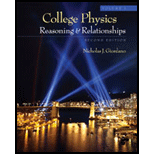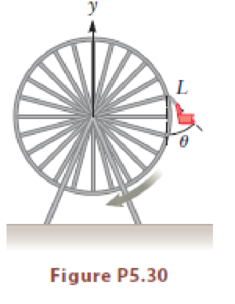
College Physics, Volume 1
2nd Edition
ISBN: 9781133710271
Author: Giordano
Publisher: Cengage
expand_more
expand_more
format_list_bulleted
Concept explainers
Textbook Question
Chapter 5, Problem 30P
Consider a Ferris wheel in which the chairs hang down from the main wheel via a cable. The cable is L = 2.0 m long, and the radius of the wheel is 12 m (Fig. P5.30). When a chair is in the orientation shown in the figure (the “3 o’clock” position), the cable attached to the chair makes an angle θ = 20° with the vertical. Find the speed of the chair. For simplicity, assume that at this moment the chair is moving in a circle of radius equal to the radius of the wheel.

Expert Solution & Answer
Want to see the full answer?
Check out a sample textbook solution
Students have asked these similar questions
A body of mass 10 kg, is moving with a velocity of 5 m/s in a circle of radius 5 m, what is the centripetal acceleration of the body?
A body of weight 20 N, mass 2 kg is moving in vertical circular motion with the help of a string of radius 1 m and with a velocity of 2 m/s. What is the tension in the string at the lowest point?
Consider an object, of mass m and speed v, moving with uniform circular motion at some radius r.
If the radius remains fixed, but the mass m is tripled and the speed v halved, the centripetal force will change by a factor of:
Group of answer choices
9/4
3/4
6
3/2
12
A particle of mass 0.50 kg starts moves through a circular path in the xy-plane with a position given by r → (t) = (4.0 cos 3t)i ^ + (4.0 sin 3t)j ^ where r is in meters and t is in seconds. (a) Find the velocity and acceleration vectors as functions of time. (b) Show that the acceleration vector always points toward the center of the circle (and thus represents centripetal acceleration). (c) Find the centripetal force vector as a function of time.
Chapter 5 Solutions
College Physics, Volume 1
Ch. 5.1 - Velocity and Acceleration in Circular Motion...Ch. 5.1 - Prob. 5.2CCCh. 5.2 - Prob. 5.3CCCh. 5.3 - Prob. 5.5CCCh. 5.4 - Prob. 5.6CCCh. 5.4 - Prob. 5.7CCCh. 5 - Prob. 1QCh. 5 - Prob. 2QCh. 5 - Prob. 3QCh. 5 - Consider the Cavendish experiment in Figure 5.22....
Ch. 5 - Prob. 5QCh. 5 - Prob. 6QCh. 5 - Prob. 7QCh. 5 - What force makes it possible for a car to move...Ch. 5 - Prob. 9QCh. 5 - Prob. 10QCh. 5 - Prob. 11QCh. 5 - Prob. 12QCh. 5 - Prob. 13QCh. 5 - Prob. 14QCh. 5 - Prob. 15QCh. 5 - Prob. 16QCh. 5 - Prob. 17QCh. 5 - Prob. 18QCh. 5 - Plutos mass. In 1978, it was discovered that Pluto...Ch. 5 - Prob. 1PCh. 5 - Prob. 2PCh. 5 - Prob. 3PCh. 5 - Prob. 4PCh. 5 - Prob. 5PCh. 5 - Prob. 6PCh. 5 - Prob. 7PCh. 5 - Prob. 8PCh. 5 - Prob. 9PCh. 5 - Prob. 10PCh. 5 - A compact disc spins at 2.5 revolutions per...Ch. 5 - Prob. 12PCh. 5 - Prob. 13PCh. 5 - Prob. 14PCh. 5 - Prob. 15PCh. 5 - Consider the motion of a rock tied to a string of...Ch. 5 - Prob. 17PCh. 5 - Prob. 18PCh. 5 - Prob. 19PCh. 5 - Prob. 20PCh. 5 - Prob. 21PCh. 5 - Prob. 23PCh. 5 - Prob. 24PCh. 5 - Prob. 25PCh. 5 - Prob. 26PCh. 5 - Prob. 27PCh. 5 - Prob. 29PCh. 5 - Consider a Ferris wheel in which the chairs hang...Ch. 5 - Prob. 31PCh. 5 - Prob. 32PCh. 5 - Prob. 33PCh. 5 - Prob. 34PCh. 5 - Prob. 35PCh. 5 - Prob. 36PCh. 5 - Prob. 37PCh. 5 - Prob. 38PCh. 5 - Prob. 39PCh. 5 - Prob. 40PCh. 5 - Prob. 41PCh. 5 - Prob. 42PCh. 5 - Prob. 43PCh. 5 - Prob. 44PCh. 5 - Prob. 45PCh. 5 - Prob. 46PCh. 5 - Prob. 47PCh. 5 - Prob. 48PCh. 5 - Prob. 50PCh. 5 - Prob. 51PCh. 5 - Prob. 52PCh. 5 - Prob. 53PCh. 5 - Prob. 54PCh. 5 - Prob. 55PCh. 5 - Prob. 56PCh. 5 - Prob. 57PCh. 5 - Prob. 58PCh. 5 - Prob. 59PCh. 5 - Prob. 60PCh. 5 - Prob. 61PCh. 5 - Prob. 62PCh. 5 - Prob. 63PCh. 5 - Prob. 64PCh. 5 - Prob. 65PCh. 5 - Prob. 66PCh. 5 - Prob. 67PCh. 5 - Prob. 68PCh. 5 - Prob. 69PCh. 5 - Prob. 70PCh. 5 - Prob. 71PCh. 5 - Prob. 72PCh. 5 - A rock of mass m is tied to a string of length L...Ch. 5 - Prob. 74PCh. 5 - Prob. 75PCh. 5 - Prob. 76PCh. 5 - Prob. 77P
Knowledge Booster
Learn more about
Need a deep-dive on the concept behind this application? Look no further. Learn more about this topic, physics and related others by exploring similar questions and additional content below.Similar questions
- Why is the following situation impossible? A book sits on an inclined plane on the surface of the Earth. The angle of the plane with the horizontal is 60.0. The coefficient of kinetic friction between the book and the plane of 0.300. At time t = 0, the book is released from rest. The book then slides through a distance of 1.00 m, measured along the plane, in a time interval of 0.483 s.arrow_forwardA fairground ride spins its occupants inside a flying saucer-shaped container. If the horizontal circular path the riders follow has a 8.00 m radius, at how many revolutions per minute will the riders be subjected to a centripetal acceleration whose magnitude is 1.50 times that due to gravity? Group of answer choices 1.36 12.9 118 10.8arrow_forwardA car is traveling at a constant speed (v = 18 m/s). Inside the car, there is a ball suspended from the ceiling by an ideal massless string. As the car rounds a curve (R = 75 m), by what angle is the ball on the string gets deflected from the vertical? Group of answer choices a. 0 degrees b. 32.2 degrees c. 1.4 degrees d. 16.8 degrees e. 24 degrees f. Cannot be determined from the information givenarrow_forward
- Determine the minimum speed necessary for a roller coaster car to pass the top of a 12 m radius loop without falling. Group of answer choices 6.67 m/s 15.0 m/s 13.1 m/s 10.8 m/sarrow_forwardThe figure shows an object of mass m = 4 kg moving in a vertical circle attached to a massless string of length L = 0.6 m. When the object is at position A, it has unknown speed v0. If the only forces acting on the object are gravity and the tension in the string, and the tension in the string at position A is 240 N, what is the tension in the string when the object is at position D (at the top)?arrow_forwardMiranda, a satellite of Uranus, is as shown. It can be modeled as a sphere of radius 242 km and mass 6.68 × 1019 kg. (a) Find the free-fall acceleration on its surface. (b) A cliff on Miranda is 5.00 km high. It appears on the limb at the 11 o’clock position as shown and is magnified as shown. If a devotee of extreme sports runs horizontally off the top of the cliff at 8.50 m/s, for what time interval is he in flight? (c) How far from the base of the vertical cliff does he strike the icy surface of Miranda? (d) What will be his vector impact velocity?arrow_forward
- A toy plane is connected to a string. You hold the free end of the string and whirl the plane horizontal circle in such a way that the plane is in uniform circular motion. Which of the following statements are true for this situation? (Select all that apply) i. The plane's speed is constant. ii. The direction of the plane's velocity changes as it moves around the circle. iii. The magnitude of the plane's velocity does not change. iv. The plane is moving with constant velocity. v. The change in direction of the plane's motion is due to the centripetal force acting on the plane.arrow_forwardIn the very Dutch sport of ducth-dude-on-a-pole, athletes run up to a long pole and then use it to vault across a canal. At the very top of his arc, a 70kg vaulter is moving at 3.5m/s and is 5.0m from the bottom end of the pole. What vertical force does the pole exert on the vaulter (in magnitude)?arrow_forwardA jet pilot takes his aircraft in a vertical loop , if the jet is moving at a speed of 1140 km/m , at the lowest point of the loop , determine the minimum radius (r) of the circle , so that the centripetal acceleration at the lowest point doesn't exceed 6.4 g's please pay attention , previously you sent the answer , but that was not correct , that's why i am sending againarrow_forward
- An owner of a speedboat loves high speed but doesn't want to go anywhere. So he tethers the speedboat to a fixed buoy by a strong cable of length 40.0 m40.0 m, which supplies all the centripetal force to run the boat in circles around the buoy. When the tension in the cable is steady at 13500 N13500 N, with what force is the boat's engine pushing the boat? Assume that the mass of the speedboat (including the driver) is 645 kg645 kg. Take the water's drag force to be (450 kg/m)×v2(450 kg/m)×v2, where vv denotes the boat's speed. Ignore any drag force on the cable. Be sure to include the free-body diagram for the boat.arrow_forwardA heavy ball of mass 1.00 kg is whirled at a constant speed of 2.00 ms−1 on the end of a string in a horizontal circle of radius 1.50 m. The tension in the string during exactly one revolution isarrow_forwardA jet pilot takes his aircraft in a vertical loop , if the jet is moving at a speed of 1140 km/m , at the lowest point of the loop , determine the minimum radius (r) of the circle , so that the centripetal acceleration at the lowest point doesn't exceed 6.4 g's and also calculate the 70 kg pilot's effective weight ( The force with which the seat pushes up on him ) at the bottom of the circle , and at the top of the circle ( assume the same speed ) FNbottom , FNtop ?arrow_forward
arrow_back_ios
SEE MORE QUESTIONS
arrow_forward_ios
Recommended textbooks for you
 Principles of Physics: A Calculus-Based TextPhysicsISBN:9781133104261Author:Raymond A. Serway, John W. JewettPublisher:Cengage Learning
Principles of Physics: A Calculus-Based TextPhysicsISBN:9781133104261Author:Raymond A. Serway, John W. JewettPublisher:Cengage Learning

Principles of Physics: A Calculus-Based Text
Physics
ISBN:9781133104261
Author:Raymond A. Serway, John W. Jewett
Publisher:Cengage Learning
What Is Circular Motion? | Physics in Motion; Author: GPB Education;https://www.youtube.com/watch?v=1cL6pHmbQ2c;License: Standard YouTube License, CC-BY